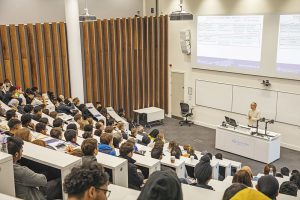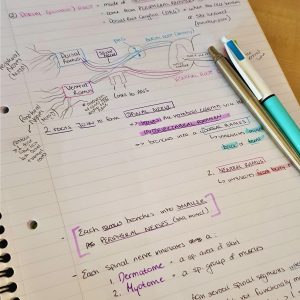Biomedicine Lectures
By Ekpreet Sahota
I’m sure you all have an image in your head of what lectures are like at university… you might even have the impression that they’re boring, with people falling asleep at the back of the room and no one paying attention after the first 10 minutes. My experience of lectures wasn’t actually like this – in this blog I will be telling you more about what my lectures were like studying Biomedicine at university.
Firstly, what content did my lectures cover?
My first year consisted of modules that covered the basics – we learned about the chemistry of biological interactions, integrative body systems, molecular and cellular biology, and statistics. This knowledge formed the building blocks we needed to understand the more difficult concepts we would be learning in our second and third year. In my second year, my modules were based on neuroscience, stem cells, pharmacology, and cardiovascular biology. However, keep in mind that different universities will choose different aspects of Biomedicine to cover so you may not have the exact same modules as me. You can definitely expect to be looking at a lot of published research papers which allows you to apply what you have learned to a real-life context. Papers may be difficult to understand and interpret at first, but they get easier the more you practice. Reading scientific papers also develops critical thinking and analytical skills, important skills required by any scientist.
understand the more difficult concepts we would be learning in our second and third year. In my second year, my modules were based on neuroscience, stem cells, pharmacology, and cardiovascular biology. However, keep in mind that different universities will choose different aspects of Biomedicine to cover so you may not have the exact same modules as me. You can definitely expect to be looking at a lot of published research papers which allows you to apply what you have learned to a real-life context. Papers may be difficult to understand and interpret at first, but they get easier the more you practice. Reading scientific papers also develops critical thinking and analytical skills, important skills required by any scientist.
How were my lectures conducted?
A traditional lecture at univers ity simply involves a lecturer at the front of the class teaching students. These types of lectures usually have little interaction between students, and mainly consist of the lecturer talking and conveying information while students take notes. Depending on the lecturer, they may release the lesson material beforehand for students to have a glance at, or they may release it after the lecture has finished. I didn’t really have ‘traditional’ lectures. At Imperial the idea of ‘flipped learning’ was implemented. This meant that I was provided with online material for each lesson – this included written information, videos of lecturers explaining a concept, and multiple-choice questions which assessed what was learned. We were expected to work through this online material and make our own notes. For each online lesson, there would also be an in-class lesson which involved active learning with teachers and classmates. The lesson would usually start off with a quiz for the teacher to see how much we learned from the online material. The teacher would then only go over any material that the class was unsure of. Sometimes the teacher would have a ‘mini-lecture’ in class to introduce us to a new concept that was not included in the online material. We would also have plenty of group activities which was a fun and engaging way to learn! In almost any lecture, you are able to ask questions like you would in class at school. This might seem a bit daunting at first since there will be a lot of people in the lecture, but remember that you would be helping yourself (and others) by asking that question!
ity simply involves a lecturer at the front of the class teaching students. These types of lectures usually have little interaction between students, and mainly consist of the lecturer talking and conveying information while students take notes. Depending on the lecturer, they may release the lesson material beforehand for students to have a glance at, or they may release it after the lecture has finished. I didn’t really have ‘traditional’ lectures. At Imperial the idea of ‘flipped learning’ was implemented. This meant that I was provided with online material for each lesson – this included written information, videos of lecturers explaining a concept, and multiple-choice questions which assessed what was learned. We were expected to work through this online material and make our own notes. For each online lesson, there would also be an in-class lesson which involved active learning with teachers and classmates. The lesson would usually start off with a quiz for the teacher to see how much we learned from the online material. The teacher would then only go over any material that the class was unsure of. Sometimes the teacher would have a ‘mini-lecture’ in class to introduce us to a new concept that was not included in the online material. We would also have plenty of group activities which was a fun and engaging way to learn! In almost any lecture, you are able to ask questions like you would in class at school. This might seem a bit daunting at first since there will be a lot of people in the lecture, but remember that you would be helping yourself (and others) by asking that question!
When deciding where to go to university, you might want to think about what style of teaching suits you.
What is the right way to take notes?
There is no right way to take notes! Everyone thinks and interprets information differently, and this usually reflects in the way you take your notes. These were some of the ways that I found people taking notes at university:
- Typing notes onto a laptop (this was the most common)
- Writing notes by hand into a notebook
- Using a ‘pen’ to write onto iPads/tablets
Personally, I found that writing notes out onto paper was the best way for me to absorb all of the information. There was something about writing with a pen rather than typing onto a keyboard which helped me learn. I would use different coloured pens and highlighters (my favourite part) to enhance key sections of information, which would also help me navigate through my notes. In Biomedicine, like any other type of science, you will be learning the names of lots of different molecules and reactions, so highlighting these keywords will make sure they don’t get ‘lost’ into the rest of your notes. When taking notes, you may find yourself copying everything that is being said word for word, but this isn’t sustainable – it does take a little time to get the hang of it and identify what are the necessary bits of information to note down.
Consolidating your learning.
After you’ve finished a class, I know the last thing you want to do is to go back and revise what you learned – but it’s actually really important to do this! Consolidating your learning a day (or a few days) after your class will make sure that what you have learned will transfer into your long-term memory. So, when exam season arrives, it should be easier to revise the material. As mentioned before, you will be learning the names of many reactions, cells, and molecules so it is best to revise these soon otherwise it may seem impossible to remember it all for exams! For concepts that would be quite difficult for me to grasp, I would watch YouTube videos from other science educators which helped reinforce my knowledge. Most lectures will also be recorded and uploaded soon after it finishes. This is great especially if you missed something during a lecture or if you were unable to attend – however I wouldn’t use this as an excuse to miss lectures on purpose.
How long would I spend on lecture-related work?
During my first year I would have 2 lectures a week, and each lecture was 3 hours long. Now, this may seem like I had plenty of free time – but I didn’t! For the two days that I had off in the week I would be:
- Reading through and taking notes from the online material. The time it took me to do this would vary depending on the length of the online material. On average, it would take me about 2-3 hours.
- Consolidating my learning from a previous lesson. I would spend around 1 hour for consolidation, however sometimes this would end up being a little more depending on how difficult the lesson was.
In a week, I would always make sure that I had written out the notes for next week’s lessons, so that way I couldn’t fall behind. Before a lecture would start, I would also spend time reading over my notes so I would be prepared for the lesson – this was a great way for me to make use of my one-hour train journey to university! During my second year, I had 3 lectures a week, and my plan for studying was very much similar to how it was in my first year.
As you can see, you do have to be motivated and put in the (sometimes long) hours in order to stay on top of everything. It is especially important to become good at studying independently at university because, unlike school, the lecturer will often go at their own pace which may not suit how you learn. Since classes at university are quite big, it will be difficult for a lecturer to identify if a student is struggling or falling behind, so it is important that you remain motivated and take initiative to work on areas that need improvement. A benefit of independent learning is that you will develop skills such as planning, prioritisation and setting deadlines/goals which are skills that become very important when you begin working on projects and dissertations.
My 3 Top Tips on how to get the most out of lectures:
- Find a method of taking notes which best maximises your ability to learn
- Take initiative to ask your lecturer any questions about something you’re unsure of
- Consolidate your learning a few days after a lecture
I hope this gave you an insight into what you might expect from lectures at university and that you have picked up some tips.


